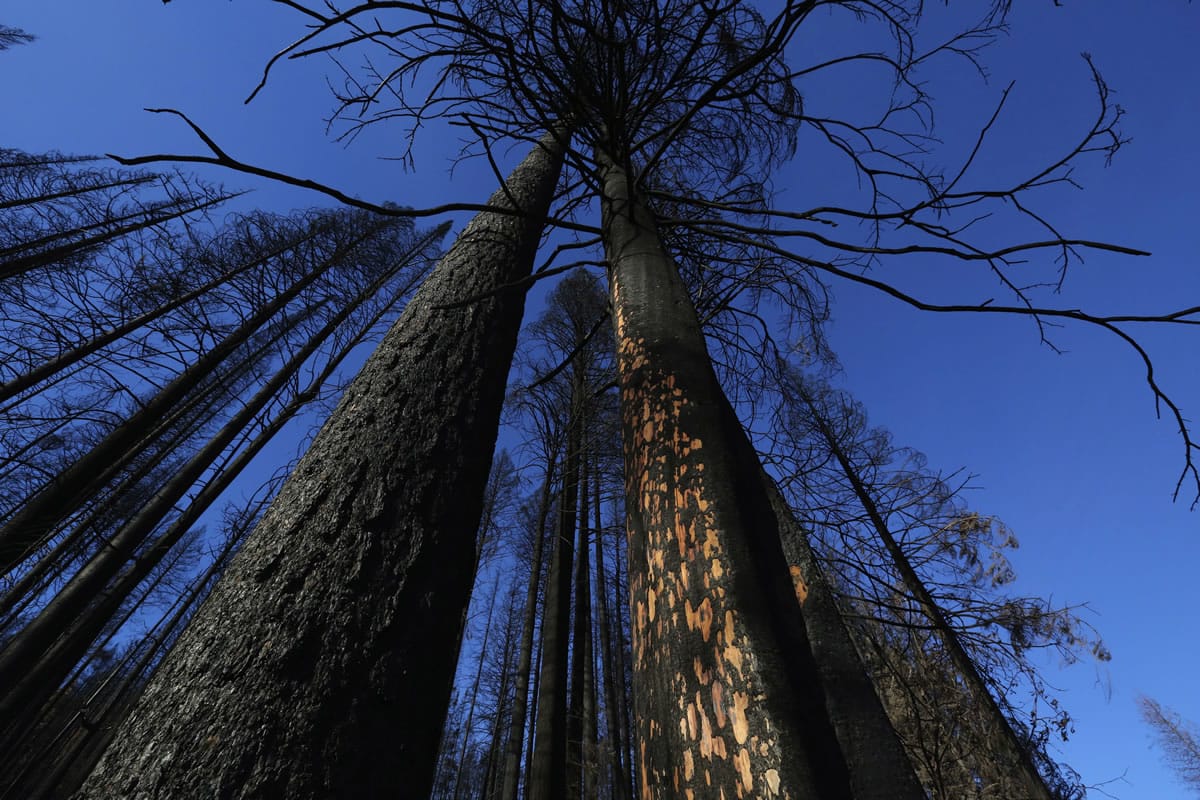COLVILLE INDIAN RESERVATION — It’s a stickpin skyline: fire-blackened trees without leaves, needles or even branches as far as the eye can see.
The quiet is deathly, until an 18-wheel logging truck roars out of the blackened woods. James Griffin hops out of cab of his logging rig. He strides past the towering tires and throws his weight into tightening the chains on a full load of ponderosa pine logs, some 3 feet around, that he is trucking out of the burn.
First came the fire, now come the loggers. The Confederated Tribes of the Colville Indian Reservation are unleashing a salvage logging operation in an emergency cut to get what value the tribes still can from charred and blackened trees. It’s a logging blitz nearly military in scope and one of the biggest ever in Washington: as many as 120 log trucks hauling more than half a million board feet of timber a day.
There isn’t enough of anything for an operation on this scale. Not enough loggers. Rigs. Mill capacity. Daylight hours in which to work.
Six days a week, 20 logging contractors and counting are cutting these burned woods, hauling what could amount to more than 20,000 tractor-trailer loads of timber to market before it’s over, enough to build 4,200 homes. In the end, the total will depend on how much wood the tribes can get out, and how much the mills will take, and at what price. The state’s largest salvage logging operation ever was about 100 million board feet of timber cut on Department of Natural Resources Lands in 2008 in Southwest Washington, after a windstorm.
The logging here now couldn’t be done this quickly on federal forest lands, if at all, said Jerry Franklin, professor of ecosystem analysis at the College of Forest Resources at the University of Washington.
“These days salvage is so controversial it is very difficult to do, and to justify,” Franklin said. “It isn’t a good decision ecologically. Salvage hardly ever contributes to the recovery of an ecosystem; it is a tax on recovery. You do it for economic reasons.”
Out to inspect the logging operation as it geared up, natural- and cultural-resources staff for the tribes recently took their first look at the destruction wrought by the fires that burned more than 250,000 acres on their reservation.
The Chelan, Tonasket, Omak and Wenatchee areas also had a terrible fire season. But the Tunk Block and North Star fires that burned here were the biggest in Washington’s historically destructive fire season. By the time these fires started in mid-August, most of the firefighters, air support and equipment already were deployed near population centers far from these woods. At the start, the tribes had only about 50 people to fight a fire that in a week grew over 76,000 acres.
Then the winds hit. The fires grew by then beyond anything people could fight.
The lungs of animals cooked in the heat. Rocks burned so hot they split. Soils seared to gray ash into the mineral depths, essentially sterilizing the ground.
A dozen families lost their homes.
Still in shock and grief, the tribes now are assessing the damage to the forests they have depended on for thousands of years for medicines, berries, animals and the timber that today makes up as much as $10 million of the $45 million annual operating budget for the tribes.
Early estimates count nearly 1 billion board feet of timber worth more than $96 million burned. Here and there, the fire still smolders. But the tribes have already cut more than 1 million board feet so far in a push to eventually salvage as much as 120 million board feet by next summer.
The tribes are cutting as much and as fast as they can, until winter shuts them down. Weather will further degrade the quality of the wood. Prices also are dropping with so much wood on the market, said Cody Desautel, natural resources director for the tribes. “It’s a race against time.”
With more than a quarter-million acres of critical winter range burned, Justin Dellinger, wildlife biologist for the tribes, worries there could be mass starvation of animals if winter is severe.
“It’s just the vastness that is unproductive, devoid of food for at least a year,” Dellinger said. Crowded into what few green reaches of habitat remain, animals out of their territory are acting in ways people here have never seen.
The tribal business council this month voted to close tribal lands in the burned areas to subsistence hunting to help conserve a base population of animals that Dellinger hopes can rebuild in perhaps two to three years.



